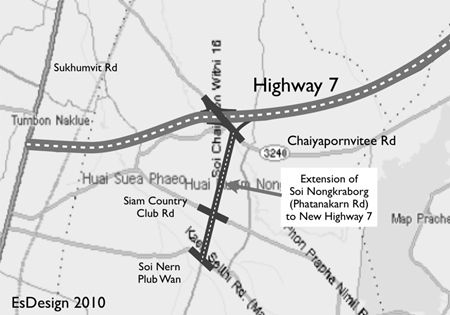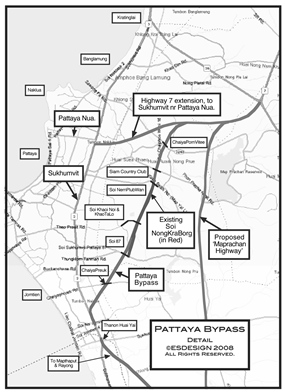Dear Sir,
We are very concerned that Pattaya’s proposed ‘Big Dig’ (‘Pattaya hopes to begin work on Central-Sukhumvit bypass in November’ PM, 12 Aug) might turn out to be as much a disaster for Pattaya as the original ‘Big Dig’ was for Boston; years over time, billions over cost.
Redevelopment of Thappraya Rd, an exercise in only two dimensions, has taken something like 4 years; & at great expense to Pattaya’s tourism and businesses, not to mention the actual cost & the questionable quality.
To rebuild the main intersection of Pattaya in three dimensions might well take forever. As well it is the busiest intersection in Pattaya; the further disruption to traffic, for however long, would further damage tourism & business.

We would like to propose an alternative to the Sukhumvit underpasses proposed; a true bypass for Pattaya, which could take all traffic from between Jomtien and Sattahip in the South, to Chonburi, Bangkok and other points North, without passing through Pattaya on Sukhumvit. This would make underpasses / overpasses unnecessary. We are aware that Railway Rd has been built since our bypass was first proposed; however, due to high levels of traffic N/S and E/W, and the traffic lights necessary, Railway Rd cannot be much more than a local road.
It is suggested that Nongkraborg Rd (also called Map Yai Lia 28, and Phatanakarn Rd) be extended N/NE on its existing alignment, to intersect Chaiyapornvitee Rd, just east of the new Highway 7 / Chaiyapornvitee Rd intersection. Nongkraborg Rd. is long and straight, extending as far south as Sukhumvit Soi 87, and with this extension North as stage 1, will also provide improved North / South access for all those living on the ‘dark side’ – East Pattaya. Most existing roads in this area are generally ‘east west’, and the improved N/S road will complement those roads.

The short North extension (2.08 km) will reduce traffic on Sukhumvit through Pattaya, just as the opening of Highway 7 has greatly reduced traffic on Sukhumvit through Banglamung. This will eliminate the need for drastic measures such as tunnels or overpasses, etc., on Sukhumvit.
The alignment of this road is almost perfect for traffic from the South of Pattaya, to Chonburi & North. This road could be built in stages; Stage One, access to Highway 7 at the Chaiyapornvitee intersection, and from Sai Chaiyapornvitee to Soi Nernplabwan.
Stage 1 – Chaiyapornvittee intersection, & Chaiyapornvittee to Soi Nernplabwan.
Stage 2, at grade from Soi 87 to Chaiyapruek.
Stage 3 would then be elevated over Chaiyapruek, and over the railway line and Sukhumvit, connecting to Sukhumvit as Sukhumvit rises near the Elephant Ride.
An advantage is that the first many might learn of this bypass is when it is to open; all roadworks could be carried out with minimal disruption of traffic, given that Phatanakarn Rd is currently very lightly trafficked. Overpasses could be built at Siam Country Club Road, and Soi Nernplabwan, and later at Soi 87 and Chaiyapruek, obviating traffic lights.
This bypass could be built at about the same cost as Mabprachan Highway, also shown on the first map; our bypass provides direct from Sattahip to Bangkok, and a further development is shown with extension from Sukhumvit in the vicinity of Ban Amphur, direct to Maptaput and Rayong. This would allow Maptaput & Rayong employees to commute directly to Pattaya. Rayong & Maptaput do not need the Mabprachan Highway; they already have more direct access to Bangkok on Highway 7.
If Council insists on reworking Sukhumvit, then it is suggested that overpasses would be better than underpasses; they are much easier to drain / less risk of flood (as noted in PM), & also much cheaper. A rule of thumb for railway design is that elevated lines cost approx 3 times the cost of lines at grade; & underground lines cost three times elevated. A similar rule of thumb could be expected to apply to roads.
Whatever course of action is taken, it is strongly recommended that Council engage the services of, e.g., a member of SPET (the Society of Professional Engineers of Thailand) to look after its, and the public’s, interest.
It is also suggested that significant infrastructure works be advised to the public, in Thai and English, with a 90 day comment period, to ensure that optimum results are achieved re effectiveness, value for money, and sustainability.
Stuart Saunders,
Pattaya Progress Association




